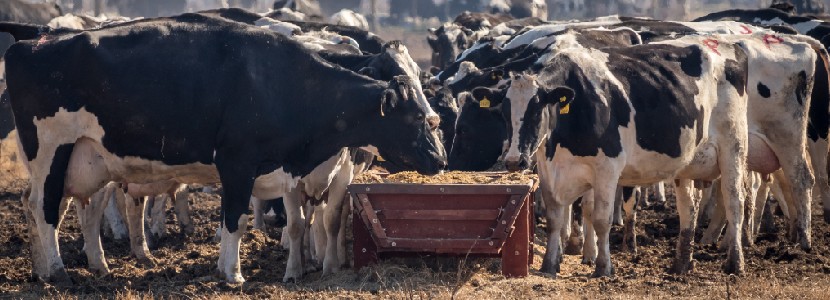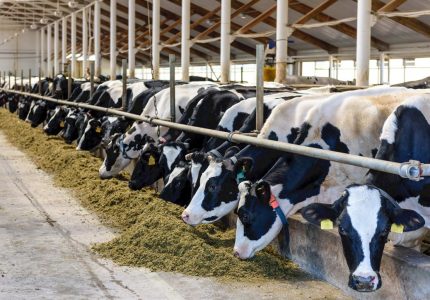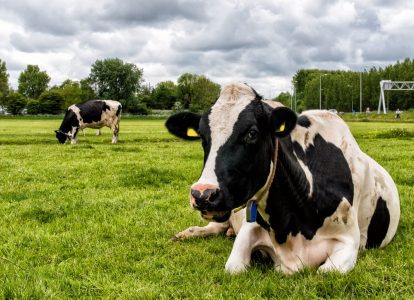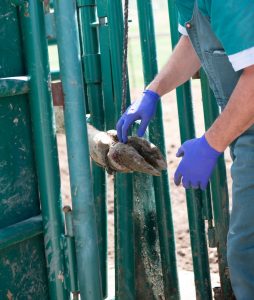 27 May 2022
27 May 2022
Feeding behavior in ruminants plays a significant role in health levels and productive parameters. This is especially true for dairy cows.
Rumination; In addition to feed consumption, rumination is a key feature in cows’ feeding behavior and a proper digestive function in livestock.
Rumination aims to make food (especially fodder) more accessible to bacteria that facilitate the fermentation of fiber and increase its digestibility.
Rumination time can also have an impact on milk production. This is probably due to the positive correlation between rumination and resting time (Fregoni et al., 2007).
Soriani et al. (2012) calculated this association and found that rumination time correlates positively (r = 0.36) with milk production (kg) during the first weeks of lactation.
Association between feeding behavior and welfare
Evidence suggests that there is a close association between feeding behaviour and animal welfare. For example, the well-known principle of the Five Freedoms includes the absence of hunger (and thirst) as a critical aspect to ensure welfare in farm animals.

Feeding behavior as a result of health and welfare problems
Any alteration in an animal’s state of health is usually related with changes in feeding behavior. This relationship has been used to identify health problems in dairy cattle. Previous studies serve as examples of how behavioral monitoring tools, such as pedometers or electronic collars, can be used to identify sick animals quickly and accurately.

![]()
The most well-known eating behavior sign associated with disease is a reduction in feed intake. [Registered]
Fogsgaard et al. (2012) reported that feeding behavior decreased when cows suffered from mastitis.
Huzzey et al. (2007) found lower dry matter intake (DMI) during the first weeks of postpartum in cows diagnosed with metritis.
Bareille et al. (2003) predicted that clinical signs of lameness associated with lesions in the hock and foot cause a decrease in DMI of 5.6 and 6.4 kg at 4 and 5 days before diagnosis, respectively. This feed intake reduction is likely to decrease milk production by about 1.2 and 3.3 kg/day, respectively.
In addition to food consumption, feeding patterns can also change during illness.
Besides intake and feeding time, other studies have shown that an increase in feeding rate is a consequence of disease and lameness, likely as a mechanism for maintaining intake (32, 73). Schirmann et al. (2012) suggested that when cows feel sick, they are less capable of successfully competing for access to the feeder. Therefore, when they have access to the feeder, they present higher feeding times(FT).

A notorious example of such relationship is the time spent eating by lame cows. Pain associated with lameness reduces standing time, including standing in the feeder, which reduces feeding time and increases BP (Cook et al. 2004).
Feeding behaviour as a potential cause of welfare problems
In addition to the causal relationship between health problems and changes in eating behavior described so far, there are some cases in which changes in eating behavior caused by external factors can increase the risk of disease.
![]() Therefore, these two components of daily feeding behavior(feed consumption and chewing) are closely linked to the pH level and acid-base balance found in the rumen.
Therefore, these two components of daily feeding behavior(feed consumption and chewing) are closely linked to the pH level and acid-base balance found in the rumen.
Animals that are forced to spend less time feeding (due to social competition for example) often try to compensate for this time deficit by eating faster. Such increases in BP can reduce salivation during feeding by 3 to 1 ml per g of DMI (Maekawa et al., 2002).
Food selection is another example of how under certain conditions, feeding behavior can lead to health problems.
Feed selection in intensively fed lactating dairy cows may increase the risk of rumen acidosis:
This pattern can result in higher consumption of fast-fermenting carbohydrates and less effective fiber compared to the formulated diet, and can result in a lower rumen pH.
![]() On the other hand, an increase in the selection of fine and short particles was associated with less time spent feeding (Greter and DeVries, 2011), which was previously identified as a risk factor for acidosis; DeVries et al. (2007), observed that when cows receive a ration containing a higher proportion of smaller particles, their consumption is much quicker.
On the other hand, an increase in the selection of fine and short particles was associated with less time spent feeding (Greter and DeVries, 2011), which was previously identified as a risk factor for acidosis; DeVries et al. (2007), observed that when cows receive a ration containing a higher proportion of smaller particles, their consumption is much quicker.
![]()
However, there are individual variations, in which some animals are more susceptible than others to rumen acidosis, and these groups may have different selection patterns (Gao and Oba, 2014). These authors fed lactating dairy cows on a high-grain diet and, depending on their acidosis index, classified them into two groups according to their response to the high-grain diet: tolerant animals and susceptible animals. Both groups selected for short particles, but susceptible animals selected this type of particle to a greater extent. In addition, susceptible animals selected against long particles, while tolerant animals did not.
Numerous studies suggest that typical food classification patterns can be adjusted based on the physiological state of the animal as a post-ingestion feedback mechanism.
| In summary, changes in feeding behavior in dairy cows can be both indicators and causes of health problems. This is especially true for metabolic diseases like rumen acidosis and the problems associated with it. |
[/register]
Subscribe now to the technical magazine of animal nutrition
AUTHORS

Nutritional Interventions to Improve Fertility in Male Broiler Breeders
Edgar Oviedo
The Use of Organic Acids in Poultry: A Natural Path to Health and Productivity
M. Naeem
Synergistic Benefits of Prebiotics and Probiotics in Poultry, Swine, and Cattle
Gustavo Adolfo Quintana-Ospina
Hybrid Rye Potential in Laying Hen Feed Rations
Gwendolyn Jones
A day in the life of phosphorus in pigs: Part I
Rafael Duran Giménez-Rico
Use of enzymes in diets for ruminants
Braulio de la Calle Campos
Minerals and Hoof Health in the Pregnant Sow
Juan Gabriel Espino
Impact of Oxidized Fats on Swine Reproduction and Offspring
Maria Alejandra Perez Alvarado